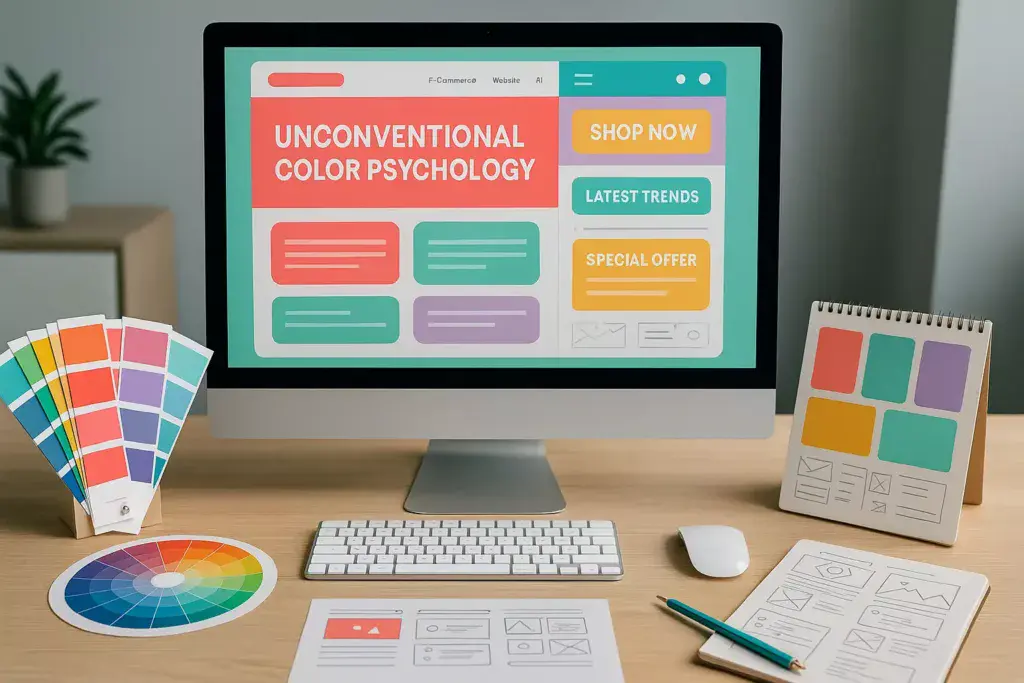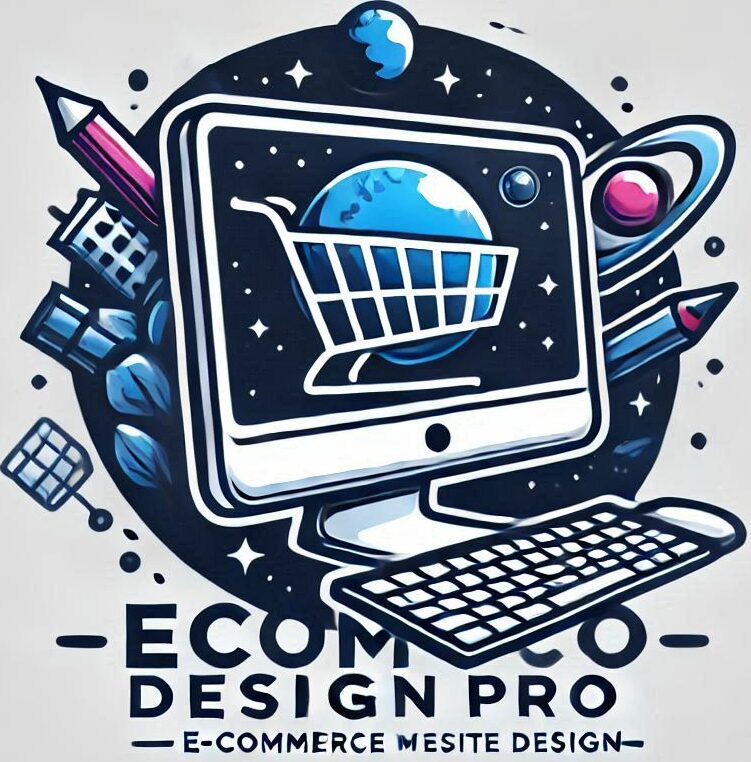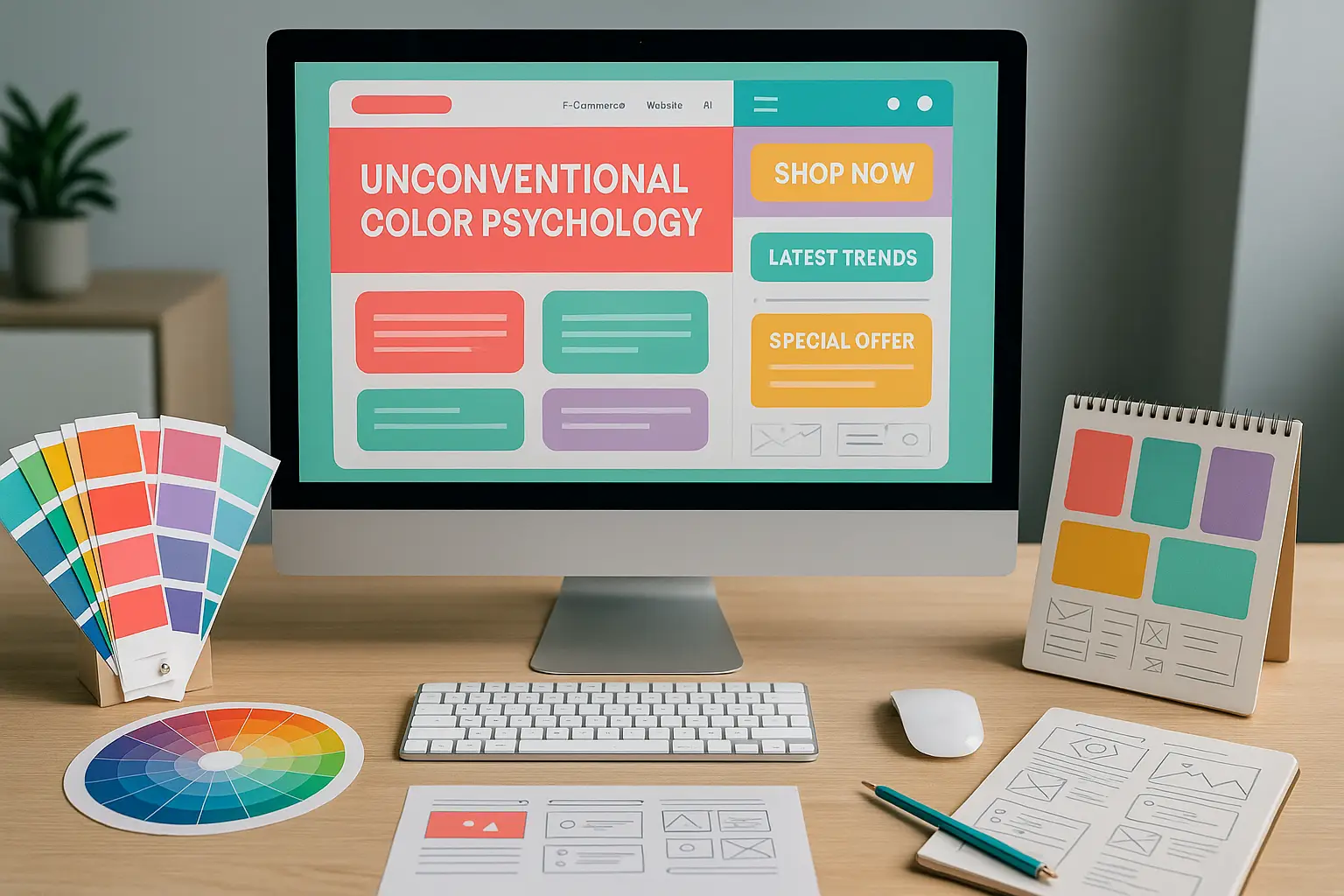
I. Introduction to Color Psychology in E-commerce
Color psychology in E-Commerce design plays a decisive role in a consumer’s decision-making process in today’s competitive digital marketplace. With attention spans growing shorter, the visual appeal of an e-commerce website can be the difference between engagement and abandonment. Among the most powerful tools at a designer’s disposal is color.
Color psychology in E-Commerce design is more than just an aesthetic choice—it’s a powerful communicator of emotion and meaning. A bold red can stir urgency and excitement, prompting action, while a cool blue may promote trust and calm. For e-commerce brands, mastering color psychology is essential in converting visitors into buyers.
Color psychology in E-Commerce design also requires cultural awareness. Colors carry different meanings around the world, making it critical for global e-commerce businesses to choose palettes that resonate universally or customize for different markets. This cultural nuance presents both a challenge and a powerful branding opportunity.
In this article, we will delve into the multifaceted world of color psychology as it pertains to e-commerce website design. We will explore the impact of color on consumer behavior, highlight unconventional color schemes that can help brands stand out, and discuss the importance of testing and optimizing color choices to enhance the user experience. By understanding and leveraging the principles of color psychology, e-commerce businesses can create more compelling and effective online experiences that resonate with their target audiences.
II. The Impact of Color on Consumer Behavior
Color psychology in E-Commerce design directly influences how customers feel about your brand from the moment they land on your website. Whether it’s excitement from a vibrant orange or calmness from a soft blue, colors are powerful emotional triggers that affect decision-making.
Color is more than just a visual element; it plays a pivotal role in shaping consumer perceptions and influencing purchasing decisions. In the realm of e-commerce, where online shoppers are bombarded with countless choices, the strategic use of color becomes essential in guiding behavior and enhancing the user experience. This section delves into how colors influence emotions, the cultural associations tied to different hues, and examines case studies of brands that have successfully utilized color to drive engagement and sales.
A. How Colors Influence Emotions
Using color psychology in E-Commerce design, brands can craft emotional experiences that align with their goals. Warm colors like red and yellow spark urgency and happiness—ideal for sales and promotions—while cooler tones foster calm and trust, key for luxury or wellness brands.
Colors evoke emotions and can significantly affect the mood of consumers when they browse e-commerce websites. For instance, warm colors like red, orange, and yellow are often associated with feelings of excitement, warmth, and urgency. These colors can encourage impulse buying and create a sense of immediacy, making them suitable for clearance sales or promotional banners. Conversely, cool colors such as blue and green tend to evoke calmness and trust, making them ideal for brands focused on health, wellness, or luxury items. Understanding the psychological effects of color allows e-commerce businesses to create tailored experiences that resonate with their target audience.
B. Color Associations and Cultural Differences
Global success with color psychology in E-Commerce design hinges on understanding cultural differences, making it critical for e-commerce brands to consider their target demographic when selecting color schemes. For example, while white is often associated with purity and simplicity in Western cultures, it can symbolize mourning and loss in some Eastern cultures. Similarly, red can signify luck and prosperity in China, while in Western contexts, it is often linked to danger or passion. Brands that operate on a global scale must navigate these cultural nuances to avoid miscommunication and ensure their messaging is well-received. By doing so, they can foster a deeper connection with diverse consumer bases and enhance overall brand perception.
C. Case Studies of Successful Color Use
Examples of color psychology in E-Commerce design can be seen with numerous e-commerce brands that have harnessed color psychology to create compelling shopping experiences. One noteworthy example is the online retailer Amazon, which prominently features a yellow “Add to Cart” button. The choice of yellow is strategic, as it is known to grab attention and evoke feelings of happiness, encouraging users to complete their purchases. Another example is the cosmetics brand Glossier, which utilizes a soft pink palette that conveys a sense of approachability and modernity, appealing to its millennial and Gen Z customer base. These case studies illustrate that when brands understand and implement color psychology effectively, they can significantly enhance user engagement and drive conversions.
In conclusion, the impact of color on consumer behavior is profound and multi-faceted. By recognizing how colors influence emotions, respecting cultural associations, and learning from successful case studies, e-commerce businesses can strategically employ color to create a more engaging and persuasive online shopping experience.
III. Unconventional Color Schemes
Applying color psychology in E-Commerce design doesn’t always mean playing it safe. Brands can gain a competitive edge by stepping away from traditional palettes and embracing unique, unexpected color combinations.
In the highly competitive landscape of e-commerce, brands are continually seeking ways to differentiate themselves from the competition. One of the most effective avenues for achieving this is through the use of unconventional color schemes. By stepping outside the traditional palettes, brands can not only capture attention but also create a memorable identity that resonates with their target audience. This section explores how unexpected colors can be strategically employed to stand out in a crowded marketplace.
A. Using Unexpected Colors to Stand Out
While many e-commerce websites rely on established color trends—such as blue for trustworthiness or green for eco-friendliness—there is significant power in choosing unexpected colors. Brands that adopt bold, non-traditional hues can evoke curiosity and intrigue, drawing potential customers in. For instance, a luxury fashion retailer might utilize a striking neon color as an accent against a more muted background, creating a visual hierarchy that directs attention to key product offerings.
Unexpected color choices can also help convey a brand’s personality. A playful, youthful brand might opt for vibrant purples or oranges, while a more sophisticated label could experiment with deep jewel tones. This deliberate use of color can communicate a brand’s values and characteristics without the need for extensive text, making a strong visual statement at first glance.
B. The Psychology Behind Contrasting Colors
Contrasting colors can be particularly effective in e-commerce design, as they draw the eye and create a dynamic visual experience. This approach can be rooted in color theory, where complementary colors—those located opposite each other on the color wheel—energize a design and heighten emotional response. For example, a site selling outdoor gear might feature earthy greens alongside bright corals to evoke feelings of adventure and excitement.
Moreover, contrasting colors can guide users through a website’s layout. By strategically placing contrasting shades to highlight buttons, calls to action, or product categories, designers can encourage users to take specific actions, such as adding items to their cart or signing up for newsletters. This method not only enhances usability but also reinforces the brand’s identity through color association.
C. Examples of Brands Leveraging Unconventional Colors
Several brands have successfully harnessed the power of unconventional color schemes to enhance their e-commerce presence. For example, the online retailer ASOS stands out with its bold use of color combinations across its website, often integrating unexpected shades that reflect current fashion trends. This approach not only captures attention but also aligns with the brand’s youthful and trendsetting image.
Another notable example is the tech company Mint, which employs a bright, modern color palette that deviates from the typical blues and grays associated with financial services. By embracing fresh greens and vivid whites, Mint communicates a sense of innovation and approachability, inviting users to engage with their platform in a way that feels less intimidating than traditional finance websites.
These examples illustrate that unconventional color schemes can be an effective strategy for e-commerce brands aiming to carve out a unique niche in their respective markets. By thoughtfully selecting and implementing unexpected colors, brands can create a powerful visual identity that resonates with consumers and fosters lasting brand loyalty.
IV. Testing and Optimizing Color Choices
In the dynamic landscape of e-commerce, where consumer preferences can shift rapidly, it is crucial for brands to not only select colors that resonate with their audience but also to continually test and optimize these choices. This section delves into effective strategies for evaluating color effectiveness, understanding consumer feedback, and iterating designs based on performance data.
A. A/B Testing for Color Effectiveness
A/B testing, or split testing, is a powerful tool in the arsenal of e-commerce businesses looking to refine their color choices. By creating two versions of a webpage—one with the original color scheme and another with a modified color palette—brands can directly compare the performance of each variant. This method allows companies to measure key performance indicators such as click-through rates, conversion rates, and overall user engagement.
For instance, if a brand is considering changing the color of its call-to-action buttons from blue to orange, A/B testing can reveal which color drives more conversions. By analyzing the data collected from both versions, businesses can make informed decisions grounded in empirical evidence rather than intuition, leading to a more effective color strategy.
B. Analyzing Consumer Feedback on Color Choices
While quantitative data from A/B testing is invaluable, qualitative insights from consumer feedback can provide a deeper understanding of how color choices resonate with users. Surveys, focus groups, and user interviews can uncover emotional responses and associations that colors evoke in potential customers.
For example, a brand may find that its target audience associates certain colors with feelings of trust and reliability, while others may provoke a sense of urgency or excitement. This information is critical for designers and marketers, as it can guide the selection of color schemes that not only align with brand identity but also connect emotionally with consumers. Furthermore, social media platforms and online reviews can serve as additional resources for gathering feedback on color perceptions.
C. Iterating Designs Based on Performance Data
Once brands have gathered data from A/B tests and consumer feedback, the next step is to iterate on their designs. This involves refining color choices based on what has proven successful in real-world applications. For example, if a particular shade of green led to higher engagement on a product page, brands might consider incorporating that color into other areas of their website or marketing materials.
The process of iteration should be ongoing, allowing brands to stay attuned to evolving consumer preferences and trends. As new color palettes emerge and cultural associations shift, continuous optimization ensures that an e-commerce site remains relevant and appealing to its audience.
In conclusion, the testing and optimization of color choices in e-commerce is not a one-time effort but rather a cyclical process of experimentation and refinement. By leveraging A/B testing, analyzing consumer feedback, and iterating designs based on performance data, brands can create visually compelling websites that enhance user experience and drive conversions. As the digital landscape evolves, so too will the strategies for effective color implementation, making it essential for brands to remain agile and responsive to the changing preferences of their consumers.
V. Conclusion and Future Trends in Color Psychology
As e-commerce continues to evolve, the role of color psychology in website design remains a pivotal factor in influencing consumer behavior. The insights gained from understanding how colors affect emotions, perceptions, and purchasing decisions are invaluable for brands looking to make a lasting impact in a competitive marketplace. The traditional associations with colors provide a foundation, but as we explore unconventional color schemes, we uncover new avenues for engaging consumers in unexpected ways.
Looking ahead, we anticipate several trends in color psychology that will shape the future of e-commerce website design. First, brands are likely to embrace even bolder and more unconventional color palettes as a means of differentiation. In a digital landscape saturated with familiar hues, utilizing surprising color combinations can create a memorable experience that captures attention. This trend not only emphasizes creativity but also allows brands to express their unique identities more vividly.
Moreover, as global e-commerce expands, the importance of cultural context in color associations will become increasingly significant. Brands that are aware of and sensitive to these differences will gain a competitive edge by crafting tailored color strategies for diverse markets. Understanding the psychological implications of colors across various cultures will enable brands to connect on a deeper level with their audiences, fostering loyalty and trust.
Additionally, advancements in technology will facilitate more sophisticated testing and optimization methods for color choices. As artificial intelligence and machine learning become more integrated into e-commerce platforms, brands will have access to more nuanced data on consumer interactions with color. This will lead to more personalized shopping experiences, where color schemes can be dynamically adjusted based on individual user preferences and behaviors.
In summary, color psychology in e-commerce is not a static field but rather a dynamic and evolving discipline. By continually experimenting with color, brands can engage consumers in innovative ways that resonate emotionally, fostering a stronger connection between the consumer and the brand. As we move forward, the intersection of creativity, technology, and cultural understanding will undoubtedly shape the future of color use in e-commerce, leading to more engaging and effective designs that enhance the overall shopping experience.



